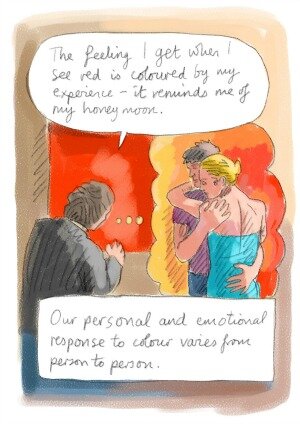Color Meanings …… not always what you expect
Color meanings, symbolically and emotionally, can vary widely from culture to culture and person to person. That’s because how we react to a particular red or yellow has a lot to do with how we’ve been programmed by our culture and our personal past experiences.
 Certain hues have the power to automatically trigger a certain response in us at a subconscious level. For instance, it might make us feel proud to see the palette of our national flag, even when used on clothing or in advertising.
Certain hues have the power to automatically trigger a certain response in us at a subconscious level. For instance, it might make us feel proud to see the palette of our national flag, even when used on clothing or in advertising.
Why is pink considered a feminine color in some cultures and not in others ?
In a delicate pink room, some women may have been conditioned, as a girl, to feel happy whereas a man may feel uncomfortable in the same environment. Yes of course, this sounds like a stereotype, but it’s a fact all the same. We have absolutely no control over how we instinctively react.
Our subconscious is definitely an underlying factor in how we interpret our surroundings.However, our subconscious associations can be gradually changed.
As an example, years ago, any man wearing a pink shirt or tie might have been mocked. These days, the fashion industry is beginning to make it perfectly normal for a man to wear pink.
See if you agree with some of these color meanings below ……
 Yellow
Yellow
 Orange
Orange
 Red
Red
 Violet
Violet
 Blue
Blue
 Green
Green
The Nature vs Nurture Debate about Reactions to Color
Even though our spontaneous reactions are strongly influenced by our past nurturing, it’s not that simple. In fact, neuroscientists are discovering that nature has hard-wired us humans to respond in highly similar ways to color stimulus.
Pretty much everyone, for example, has a strong response to bright red. It’s the neural memories and associations of red that will vary with each individual.
Even the more subtle tones evoke color meanings.
Color is a unique language with its own vocabulary. Just like words, color emits emotional energy.The meaning can be changed completely, simply by changing the tone or intensity.
The millions of hues, tints, tones and shades swirling around us every waking moment affect us all. Most of the time we’re not even aware of it. Everything has a color, no matter how subtle, black or white.
Every single hue, tint, shade and tone influences our thinking and makes us react in some way. The colors we choose to surround ourselves in our environment play a huge role in how we feel.
When selecting color schemes, for any reason, it’s important to think about the impression you might be making. Think about how the palette makes you feel and about how you want your viewer to feel.
Did you know ? The Palette you choose can:
- create a tranquil mood
- create a party atmosphere
- emphasize a point
- sell something
- communicate an idea ….. and much more.
Color Meanings is NOT a science – but it’s fun.
There are no foolproof rules about exact color meanings. Psychology experts usually do agree on broad meanings and general color symbolism associated with various cultures. But when it comes to specifics, there are many disagreements.
Nearly every color has both positive and negative emotions associated with it at least some of the time. One of the main reasons for this is that changing the intensity or tone of the hue can create an entirely different mood.
Remember too that we rarely see a color in its purest state. Most of what we see aremixtures of several hues. This mingling of various meanings and associations can add to theambiguity of what a color means to someone.
The general meanings are fun to think about. If nothing else, you might just notice your own reaction to colors as you go about your day.
Meanings of Yellow / Orange / Red / Violet / Blue / Green

